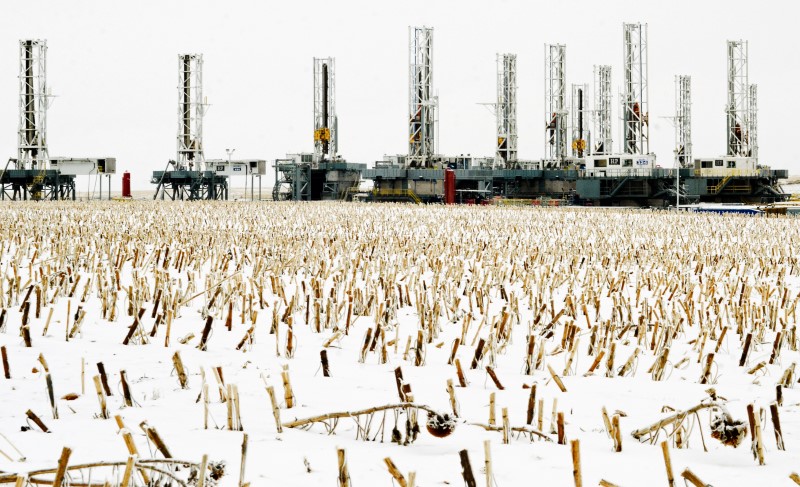By Devika Krishna Kumar
NEW YORK (Reuters) - U.S. oil producers reeling from an 18-month price rout have cautiously begun hedging future production this week, fearing this may be their best chance yet to lock in a $45 a barrel lifeline for 2017 and beyond.
As oil markets rebounded from 12-year lows this week, U.S. shale companies - for the first time in months - started inquiring and placing new hedges for the next few years, according to three market sources familiar with money flows.
Oil prices have crashed more than 70 percent in the past 20 months, driven by near-record production by the Organization of the Petroleum Exporting Countries and other producers, adding to one of the worst supply gluts in history.
On Thursday, even as immediate-delivery oil futures ended slightly higher, U.S. crude for December 2017
Trading volume in over-the-counter oil swaps was more than five times higher than the past three days combined, according to swaps data from the Depository Trust & Clearing Corp, available via Thomson Reuters Eikon.
The re-emergence of hedging interest, which traders said was still limited in scope for now and mainly in the form of inquiries rather than execution, came as a surprise to some, surfacing below the $50 psychological threshold that some traders had thought would be needed to coax back producers.
The activity likely reflects both the growing investor and lender pressure to safeguard heavy debt requirements down the road, as well as the fact that drilling costs continue to decline, allowing companies to break even at lower prices.
"The $45 is break-even for a lot of producers. It's not just about making a profit, it's about staying alive," one trader said.
The sources declined to say which companies were active this week, but some producers have been looking for an excuse to pounce. They may have found it this week, as prices surged on news that OPEC and non-OPEC oil producing countries would come together to freeze production at January levels and key producer Iran voiced its support for the output cap.
Denbury Resources Inc (N:DNR), for instance, said on Thursday that it had "recently" increased its fourth-quarter hedges to cover 30,000 barrels a day at around $38 a barrel.
"These are not great prices, but they protect our liquidity and will minimize our borrowings in the event that prices are lower for longer, because these hedges are above our total current cash costs," Chief Financial Officer Mark Allen told analysts.
On an investor call last week, Scott Sheffield, chief executive officer of Pioneer Natural Resources (N:PXD), one of the most heavily hedged drillers in the business, said he saw a good chance of more rumours stoking prices. He cited a Feb. 11 Reuters story that first reported that some OPEC countries are trying to achieve a consensus among the group and key non-members to freeze output.
With talk of declining U.S. shale output or supply curbs, "you've got to use events like that to put hedges in the marketplace."
Pioneer did not immediately respond to requests for comment. Just a month earlier, Pioneer's chief operating officer, Tim Dove, had told Reuters that the company would be looking for a minimum price of around $50 a barrel to lock in more hedging, but oil's relentless rout may have softened that view.
Matador Resources (N:MTDR) said this week it had added to its hedges over the past two weeks, but did not say by how much. It now has 43 percent of its estimated 2016 oil output hedged at weighted average floor and ceiling prices of $44 and $66.
CAPPING THE MARKET?
Hedging for future production is common among U.S. oil and gas producers, who use it as a lifeline to protect future profits and continue pumping. The need to hedge appears to be greater than ever, with some estimating that only 14 percent of 2016 oil output is protected.
The price slump since mid-2014 has effectively forced even the most resilient U.S. shale producers to slash additional spending and idle rigs in an effort to rein in costs and help balance a market battling with oversupply.
Some dealers have warned that companies' increased appetite for hedging may stymie a sharper recovery in prices, allowing them to increase drilling more quickly than they otherwise might.
"If I were a producer, I'd be saying that we will be lower for a lot longer. So I'd be locking in prices now," said Tariq Zahir, an analyst at Tyche Capital Advisors in New York. "But any spikes we see will just turn shale back (on)."
On Wednesday, data showed that output from North Dakota, the birthplace of the U.S. shale boom, fell nearly 3 percent in December and state regulators said it was a sign producers were not expecting prices to rise any time soon.
